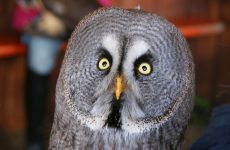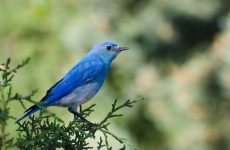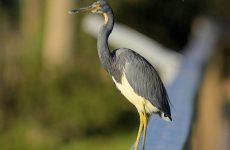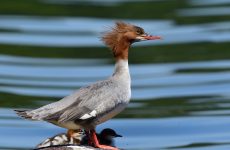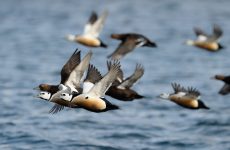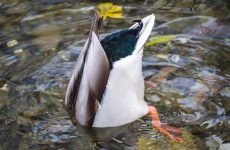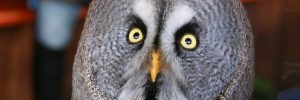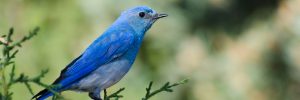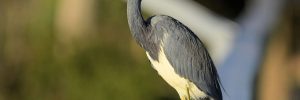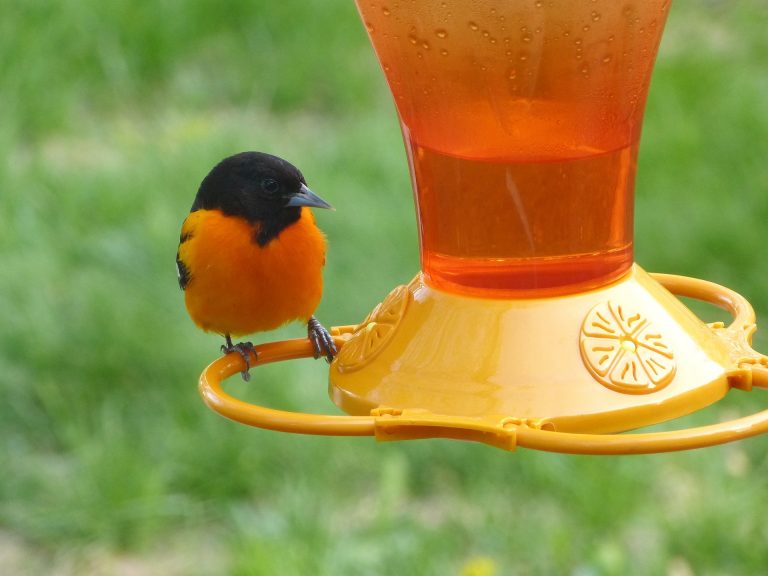
Bright visiters of spring and summer, orioles brighten up your day. These birds weave amazing hanging nests and feed on fruit, nectar and insects.
Baltimore and Orchard Orioles can be found in the east of the US and Bullock’s and Scott’s orioles can be found in the west. The other species of oriole are found in the south or Florida so if you want to see more than a trip to the south will be needed.
Find out about all the 9 species of oriole that visit the US and Canada.
These tips will make it easy to attract orioles to your yard.
9 Species of Oriole in North America:
- Baltimore Oriole
- Bullock’s Oriole
- Streak-backed Oriole
- Spot-breasted Oriole
- Orchard Oriole
- Scott’s Oriole
- Hooded Oriole
- Altamira Oriole
- Audubon’s Oriole
1. Baltimore Oriole
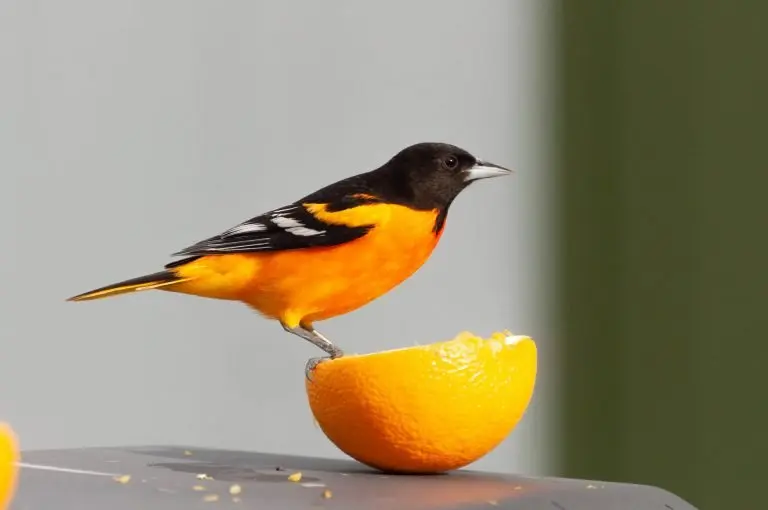
Baltimore Orioles are a colorful sign of spring in the east of North America. The adult males are bright orange and black with white wing bars on the black wings.
Females are yellowish underneath and on the head and grayish-brown on the wings, their backs or brownish-yellow. They are about the size of a Robin but more slender and are members of the blackbird family.
- Length: 6.7-7.5 in (17-19 cm)
- Weight: 1.1-1.4 oz (30-40 g)
- Wingspan: 9.1-11.8 in (23-30 cm)
Breeding in Eastern and Central States, including central-southern Canadian provinces and along the southern border with the US, from April.
Baltimore Orioles, then migrate to Florida, Central America, and the Caribbean for winter, leaving as early as July.
They make incredible hanging bag-like nests woven from fibers.
Baltimore Orioles can be found high up in open woodland, riverbanks, and forest edges foraging for insects and fruit and they often come to parks and backyards.
Their diet is insects such as beetles, crickets, and grasshoppers as well as spiders and snails and they help eat pest species. They eat a wide variety of fruits and can damage crops such as raspberries, mulberries, cherries, bananas, and oranges.
To attract more Baltimore Orioles to your yard try oranges cut in half on a platform feeder or hanging from trees. Also, oriole feeders filled with sugar water. Plant fruit and nectar plants such as raspberries, crab apples, and trumpet vines.
2. Bullock’s Oriole
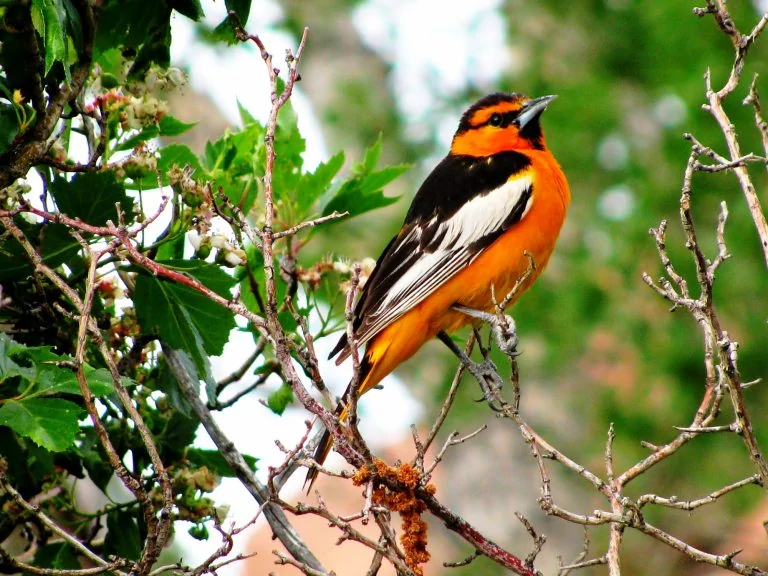
Bullock’s Orioles males are bright orange with black and white wings and black markings on their heads.
Females and immature are duller in comparison with gray backs and yellow heads, tails and chests.
- Length: 6.7-7.5 in (17-19 cm)
- Weight: 1.0-1.5 oz (29-43 g)
- Wingspan: 12.2 in (31 cm)
Bullock’s Orioles breed in the western half of the US and spend the winter in Mexico. Their nests are woven from hair, grass and wool into a gourd shape and take up to 15 days to complete.
They can be found in open woodlands and parks and will visit backyards for fruit and grape jelly and nectar feeders.
3. Streak-backed Oriole
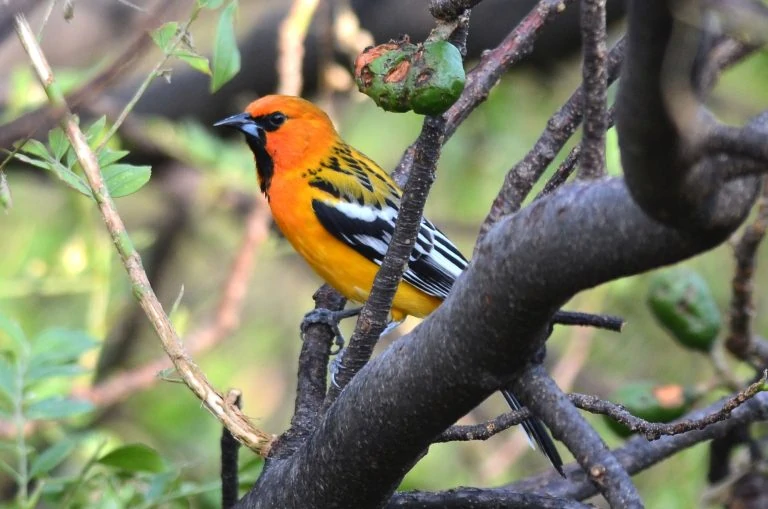
Credit: Oregon State University
Streak-backed Orioles are orange and black orioles with orange heads and undersides and black-streaked wings and a black tail. They have black around the eyes and chin.
They are rare in the US but can be seen in the southwest. Mexico and Central America is their main habitat.
They are found in tropical woodland, grassland and backyards.
4. Spot-breasted Oriole
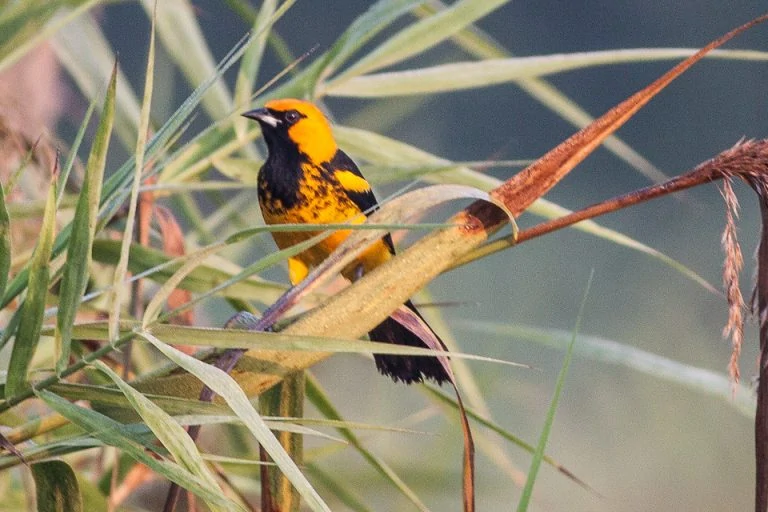
Credit: Ron Knight
Spot-breasted Orioles are black and orange with black spotting on their breast and white on the wing edges. They have black around the face and chest and are black on the back, wings and tail. Juveniles are more yellow in color with dark backs, wings and tails.
- Length: 8.3-9.4 in (21-24 cm)
- Weight: 1.8 oz (50 g)
Spot-breasted Orioles can be found in Florida and along the Gulf Coast but they are not very common in the US. They mostly live in Mexico and Central America along the Pacific Coast.
They live in open woodlands and will visit backyards for fruit and nectar.
5. Orchard Oriole
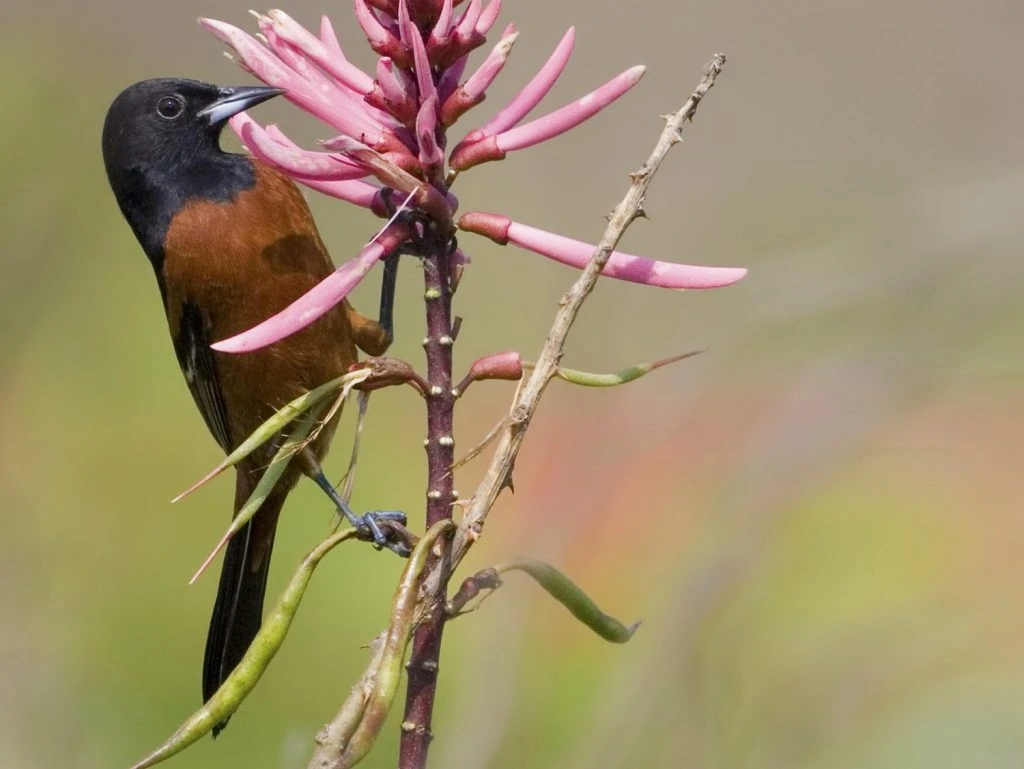
Orchard Orioles females are greenish-yellow overall, paler underneath and darker on the back, with darker wings and white wingbars. Males look very different with black heads and backs and with reddish undersides.
- Length: 5.9-7.1 in (15-18 cm)
- Weight: 0.6-1.0 oz (16-28 g)
- Wingspan: 9.8 in (25 cm)
Orchard Orioles breed in central and eastern states in summer, before migrating south to Mexico and Central America.
Preferring open woodland, Orchard Orioles can also be found along river banks and open shrubland and farms as well as backyards. They build hanging pouch-like nests.
Their diet is mostly insects such as ants, caterpillars, beetles, and grasshoppers, as well as spiders. they will also drink nectar from flowers and eat fruit such as mulberries and chokeberries.
To attract Orchard Orioles to your yard try hummingbird feeders or platform feeders with cut oranges or mango. Also, plant native berry plants such as mulberries or chokeberries.
6. Scott’s Oriole
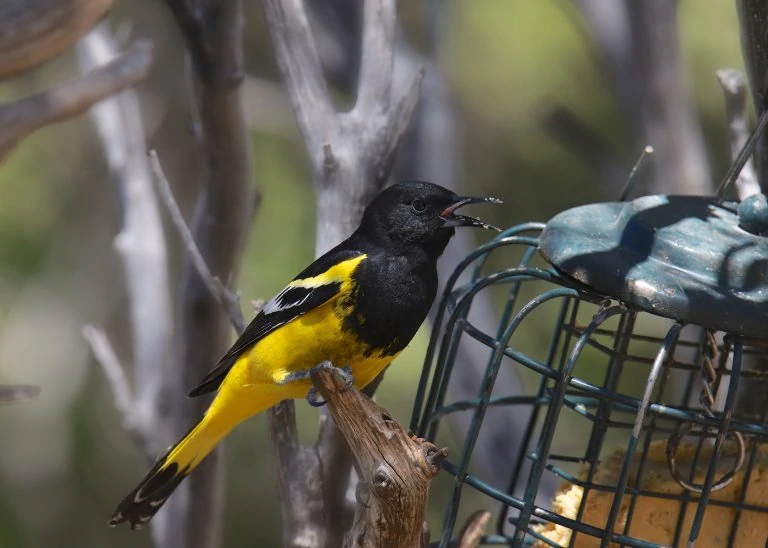
A large distinctive oriole with a bright yellow underside and black head and back in the males. Females are a paler yellow with olive-brown backs.
- Length: 9.1 in (23 cm)
- Weight: 1.1-1.4 oz (32-41 g)
- Wingspan: 12.6 in (32 cm)
Scott’s Orioles breed in southwestern US states and Mexico. They also remain all year in southern Mexico and Baja California.
They can be found on higher slopes in arid areas feeding on insects, nectar and fruit. They are often found on yuccas and begin singing before dawn.
They will feed on toxic monarch butterflies by finding the ones with the least toxins and eating those.
Nests are often quite low down at only 5 – 7 feet and are a basket of cactus fibers, grass and yucca leaf. They may have 2 or 3 broods in a year.
7. Hooded Oriole
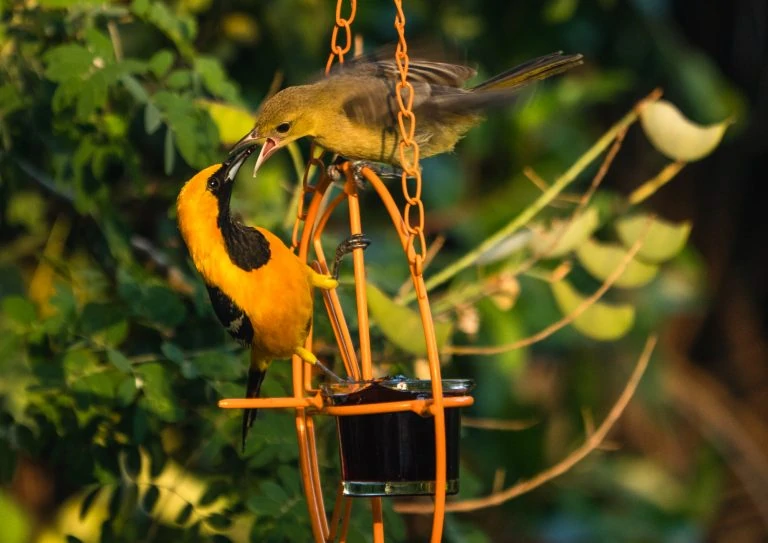
Male Hooded Orioles range from bright yellow to bright orange, with black throats and backs. Females and immatures are more yellow with grayish wings. Females lack the black face markings.
- Length: 7.1-7.9 in (18-20 cm)
- Weight: 0.8 oz (24 g)
- Wingspan: 9.1-11.0 in (23-28 cm)
Hooded Oriole males in Texas tend to be orange in color but those further west are yellow.
They breed in the southern US states, making hanging nests on the undersides of palm fronds. They winter in Mexico and some remain all year on the Gulf Coast of Mexico and Central America.
Some Hooded Orioles have stopped migrating from southern US states because of the ready supply of food from nectar feeders.
They live in dry open areas, especially near palm trees. Their nests are high at around 20 feet off the ground and are a hanging basket weaved from grass and plant material.
They will come to nectar feeders or use fruit to attract orioles.
8. Altamira Oriole
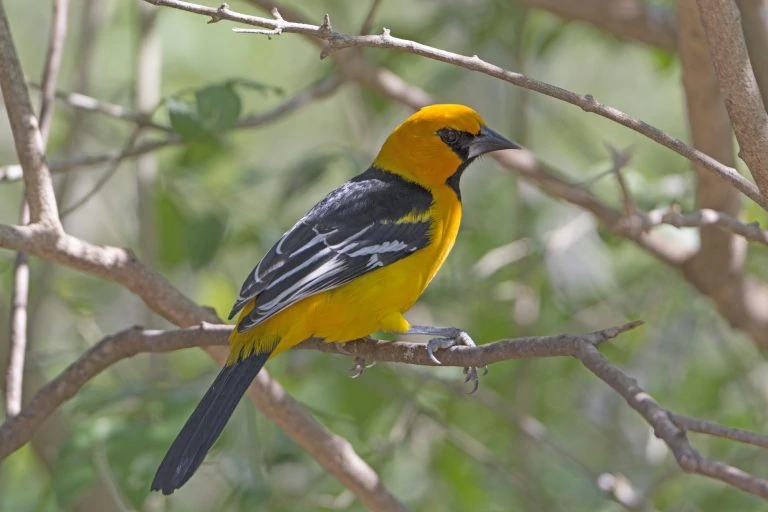
Altamira Orioles are bright yellowish-orange with black backs, wings and tails. They also have black around the eyes and down the throat. Juveniles are more yellow and have olive backs rather than black.
- Length: 8.3-9.8 in (21-25 cm)
- Weight: 1.7-2.3 oz (47-64 g)
- Wingspan: 14.2 in (36 cm)
Altamira Orioles are rare in the US except in the Rio Grande Valley, Texas and they remain year-round.
Look for them in backyards at sunflower or nectar feeders or in wildlife refuges in southeastern Texas and along the Gulf Coast of Central America. They prefer open woodlands.
Altamira Orioles stay in pairs year-round. Try to look for their amazing hanging nests that measure up to 2 feet long.
9. Audubon’s Oriole
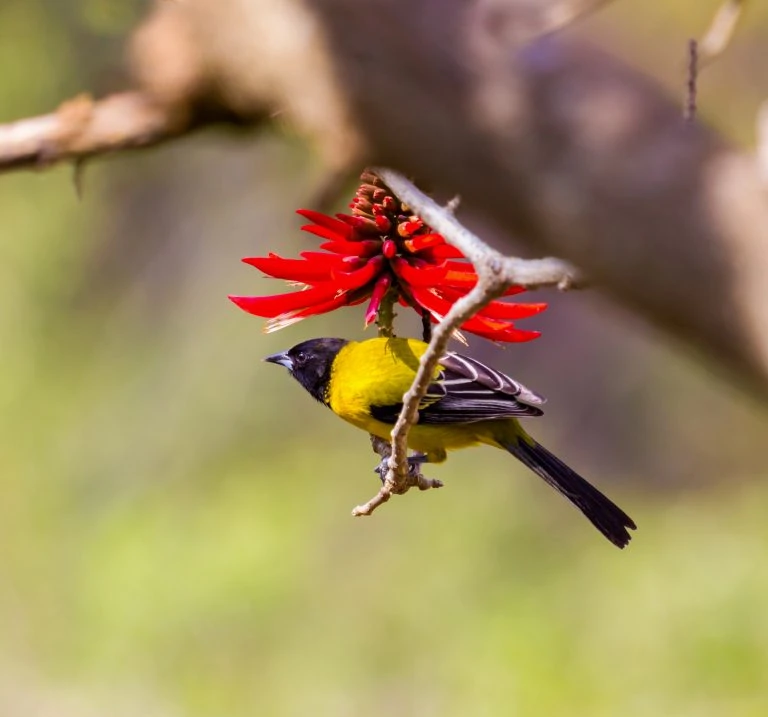
A bright yellow and black oriole with black wings and tail and a black head and throat. Males and females are similar.
- Length: 7.5-9.4 in (19-24 cm)
- Weight: 1.1-1.9 oz (31-53 g)
- Wingspan: 12.6 in (32 cm)
They have a small range and do not migrate. Audubon’s Orioles live in southeastern Texas and Mexico.
Audubon’s Orioles can be found in wooded areas or thickets and they will come to backyards for sunflower seeds and nectar feeders. They can be hard to see as they are shy and forage for insects and fruit in thick vegetation.
The nests of Audubon’s Orioles are often the favored new homes for cowbird eggs.
Best Feeders to Attract Orioles
Orioles eat fruit and nectar, especially during migration. In the summer they also eat more insects.
Feeders that allow for fruit and jelly as well as nectar feeders for orioles are best.
Best all-round feeder – Birds Choice Oriole Fest 3 Way Feeder
Best Budget feeder – Health Outdoor Hanging feeder
Best jelly feeder – Perky Pet jelly feeder

